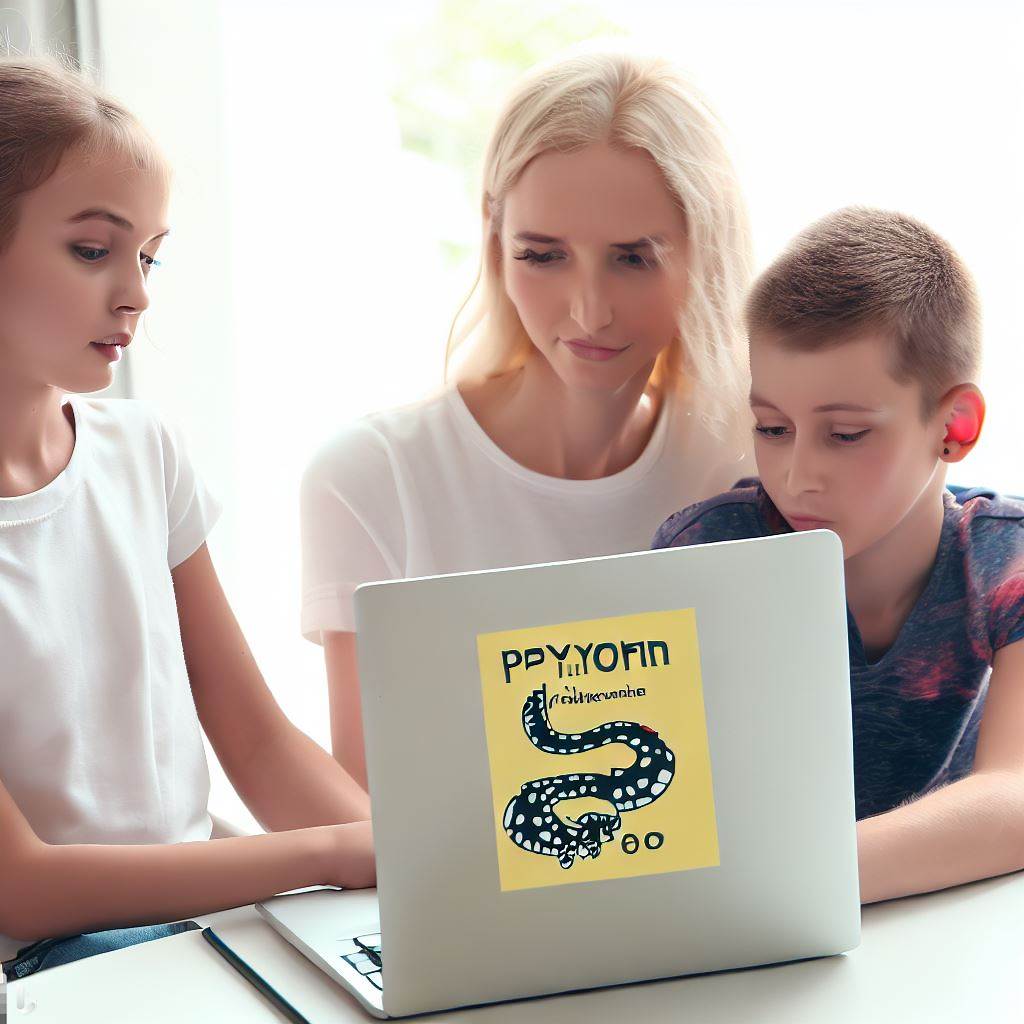Introduction
In today’s digital world, teaching coding to kids is of utmost importance. It helps them develop critical thinking, problem-solving skills, and creativity.
One specific language that is highly recommended for kids is Python.
Python brings numerous benefits to young learners. It has a simple and readable syntax, making it easy for kids to understand and learn.
It also has a vast community and extensive documentation, providing resources for continuous growth.
This blog post aims to provide a comprehensive guide for parents to teach Python to their kids.
It will cover various aspects, from basic concepts to more advanced topics.
Parents can utilize this guide to introduce their children to the world of programming in a fun and interactive way.
Why Choose Python for Kids?
- Python’s simplicity, readability, and beginner-friendly syntax make it an ideal programming language for kids.
- Python has a wide range of applications and real-world uses, from web development to scientific computing.
- There is an abundance of learning resources and online communities dedicated to teaching Python to kids.
When it comes to introducing programming to kids, Python is often the language of choice for parents and educators.
Its simplicity, readability, and beginner-friendly syntax make it an ideal programming language for young learners.
In this section, we will explore why Python is a great choice for teaching kids.
Python’s Simplicity, Readability, and Beginner-Friendly Syntax
One of the main reasons why Python is popular among kids is its simplicity.
Python emphasizes clean and straightforward code, making it easy for beginners to understand and write.
The language’s syntax is designed to be readable, with minimal punctuation and a clear structure.
This simplicity and readability help kids focus on the logic and problem-solving aspects of programming rather than getting lost in complex syntax.
Wide Range of Applications and Real-World Uses
Python’s versatility and wide range of applications also make it an excellent choice for kids.
Tech Consulting Tailored to Your Coding Journey
Get expert guidance in coding with a personalized consultation. Receive unique, actionable insights delivered in 1-3 business days.
Get StartedPython can be used for web development, data analysis, game development, robotics, and more.
By learning Python, kids can explore various fields and discover practical applications for their coding skills.
This real-world relevance can significantly enhance their motivation and engagement in learning programming.
Abundance of Learning Resources and Online Communities
When teaching Python to kids, there is no shortage of learning resources and online communities dedicated to supporting young learners.
Numerous websites, coding platforms, tutorials, and books specifically cater to kids learning Python.
These resources provide step-by-step guidance, interactive coding exercises, and fun projects to keep kids motivated and engaged.
Additionally, online communities and forums allow kids to connect with other young programmers, share their work, and seek help when needed.
In essence, Python is an excellent programming language for teaching kids due to its simplicity, readability, wide range of applications, and abundant learning resources.
By embracing Python, parents can empower their children with valuable programming skills and ignite their passion for technology and problem-solving.
Read: From Coding Wars to Tech Stardom: Iconic Programmer Journeys
Age Appropriateness
Recommended age range for introducing Python
- Python can be introduced to kids as young as 6-8 years old.
- At this age, children have developed enough cognitive skills to understand basic programming concepts.
- However, it is important to consider individual readiness and interest when determining the appropriate age.
- Some children may show interest and aptitude for programming at an earlier age.
Adjustable difficulty levels based on age and experience
- Python can be adapted to different difficulty levels based on children’s age and prior programming experience.
- For younger children, it is recommended to start with visual programming platforms.
- These platforms use block-based coding interfaces that are more intuitive for beginners.
- As children progress and become more comfortable, they can transition to text-based coding in Python.
- Advanced concepts, such as algorithms and data structures, can be gradually introduced as children mature.
The importance of adapting teaching methods to children’s learning styles
- Children have different learning styles, including visual, auditory, and kinesthetic.
- When teaching Python to kids, it is crucial to adapt the teaching methods to their individual learning styles.
- For visual learners, using diagrams, images, and videos can enhance their understanding.
- Auditory learners may benefit from listening to explanations and participating in discussions.
- Kinesthetic learners learn best through hands-on activities and interactive coding exercises.
- By catering to different learning styles, parents can provide a more effective and engaging learning experience.
In fact, introducing Python to kids at an appropriate age and adapting the difficulty level and teaching methods to their individual needs are essential for a successful learning experience.
Remember that the recommended age range can vary for each child, and it is important to consider their readiness and interest.
By recognizing and accommodating different learning styles, parents can provide a supportive environment for their children to learn and excel in programming.
Read: Asynchronous Programming in Python: Asyncio Guide
Build Your Vision, Perfectly Tailored
Get a custom-built website or application that matches your vision and needs. Stand out from the crowd with a solution designed just for you—professional, scalable, and seamless.
Get StartedGetting Started
Choosing the right Python IDE or programming environment
- Research and compare different Python IDEs, considering features tailored for beginners.
- Look for IDEs with user-friendly interfaces, interactive shell, and syntax highlighting for easy coding.
- Check for additional features like debugging tools, auto-completion, and project management options.
- Consider IDEs specifically designed for kids, offering simplified interfaces and educational resources.
- Consult online reviews and recommendations from experienced Python programmers and educators.
Installing Python on the child’s computer
- Decide on the Python version to install (preferably the latest stable version).
- Visit the official Python website and download the installer compatible with the child’s operating system.
- Run the installer and follow the installation wizard’s instructions.
- Select the appropriate installation options, such as adding Python to the system PATH for easy command line access.
- Test the installation by opening the command prompt and typing “python” to access the Python interpreter.
Alternative options for coding on different devices (tablets, smartphones, etc.)
- Explore coding apps specifically designed for kids, offering simplified Python coding environments.
- Look for apps that provide interactive coding challenges, tutorials, and mini projects for hands-on learning.
- Consider using web-based coding platforms that support Python programming on various devices.
- Research Python code editors and compilers available for specific devices, such as tablets or smartphones.
- Choose options that provide a conducive coding experience and support the child’s learning journey.
Starting to teach Python to kids is exciting.
Here’s a guide to choose the right Python IDE and environment:
- Research IDEs: Explore and compare Python IDE options suitable for beginners.
- User-Friendly Features: Prioritize IDEs with interactive shells, syntax highlighting, and user-friendly interfaces.
- Additional Tools: Look for debugging, auto-completion, and project management features.
- Kid-Friendly IDEs: Consider IDEs designed for kids, offering simplified interfaces and age-appropriate resources.
- Python Installation: Choose the latest stable Python version, download from the official website, and follow the installation instructions.
- Testing Python: Verify the installation by accessing the Python interpreter via the command prompt.
- Alternative Devices: Explore coding apps, web-based platforms, and code editors for tablets and smartphones.
- Web-Based Platforms: These platforms allow Python programming on various devices with internet access.
- Code Editors for Devices: Find Python code editors compatible with your child’s device for a conducive learning experience.
By selecting the right environment and considering alternatives, you ensure an enjoyable Python learning journey for your child.
Read: Why Python Remains the Top Choice for First-time Coders
Structuring Lessons
When it comes to teaching Python to kids, structuring lessons is crucial for effective learning.
Here are some strategies to consider:
Breaking down concepts into bite-sized, manageable chunks
- Introduce one concept at a time to avoid overwhelming kids with information.
- Start with simple concepts like variables and gradually progress to more complex ones.
- Use real-life examples to make abstract concepts easier to understand.
- Provide ample opportunities for practice and review before moving on to the next concept.
Incorporating interactive and hands-on activities
- Engage kids in activities that require active participation, such as coding exercises.
- Encourage problem-solving by giving them coding challenges to solve independently or in groups.
- Utilize visual aids, such as diagrams or colorful illustrations, to enhance understanding.
- Have kids work on projects that align with their interests to keep them motivated and engaged.
Using gamification techniques to make learning fun
- Turn learning into a game by creating coding challenges with levels and rewards.
- Implement a point system or leaderboard to encourage healthy competition among students.
- Consider using educational coding apps or websites with built-in gamification features.
- Incorporate storytelling or narrative elements to create an immersive learning experience.
By using these strategies, parents can structure Python lessons in a way that maximizes learning and enjoyment for kids.
Remember, the ultimate goal is to foster a love for coding and promote a growth mindset.
Breaking down concepts allows children to grasp each idea fully and build a strong foundation for more advanced topics.
It prevents them from feeling overwhelmed and boosts confidence in their abilities.
Bite-sized, manageable chunks also make it easier for parents to assess their child’s progress and provide targeted feedback.
Incorporating interactive and hands-on activities ensures active engagement and participation.
By coding and problem-solving, kids develop critical thinking and logical reasoning skills.
They learn to approach challenges methodically, which can be applied both in programming and everyday life.
Optimize Your Profile, Get Noticed
Make your resume and LinkedIn stand out to employers with a profile that highlights your technical skills and project experience. Elevate your career with a polished and professional presence.
Get NoticedVisual aids further enhance understanding, especially for visual learners.
Gamification techniques create an enjoyable learning environment.
By turning lessons into games, children become more motivated, enthusiastic, and invested in their own education.
The element of competition, either with others or oneself, encourages a sense of achievement and pushes kids to improve.
Gamification also helps alleviate the fear of failure and promotes a growth mindset, where mistakes are seen as opportunities to learn and grow.
Basically, structuring Python lessons for kids involves breaking down concepts, incorporating interactive activities, and implementing gamification techniques.
These strategies not only facilitate learning but also make the process enjoyable.
By making coding fun and accessible, parents can empower their children to embrace technology and develop valuable skills for the future.
Read: Why Coding Skills are Essential for Kids’ Future Success

Teaching Methodologies
Guided instruction with examples and step-by-step tutorials
Teaching Python to kids requires a structured approach that includes clear instructions and ample examples.
By providing step-by-step tutorials, parents can guide their children through the learning process.
Project-based learning to encourage creativity and problem-solving
Encouraging kids to learn Python through project-based learning is a fantastic way to ignite their creativity and enhance their problem-solving skills.
By working on real-world projects, children can apply their coding knowledge in practical ways.
Pair programming and collaborative learning experiences
Pair programming is a teaching methodology where two students work together on a coding task.
This approach fosters collaboration and enhances learning as kids can discuss ideas, solve problems, and learn from each other’s strengths.
Cooperative learning can also be achieved through group sessions and activities that promote teamwork and communication.
By implementing these teaching methodologies, parents can make the process of learning Python engaging and effective for their children.
Here are some additional tips to optimize these methodologies:
- Start with simple concepts and gradually increase the complexity to ensure comprehension.
- Encourage kids to take ownership of their learning process by allowing them to choose projects of interest.
- Provide regular feedback and constructive criticism to help improve their coding skills.
- Utilize online resources, such as interactive coding platforms and educational websites, to enhance the learning experience.
- Organize coding competitions or challenges to motivate kids and cultivate a sense of healthy competition.
- Incorporate gamification elements, such as badges or rewards, to make learning Python more enjoyable.
It’s crucial to tailor the teaching methodologies to suit each child’s learning style and preferences.
Some kids may thrive with hands-on project-based learning, while others may prefer guided instruction.
Parents should observe their children’s progress and adapt their teaching strategies accordingly to ensure maximum engagement and understanding.
Remember, learning Python should be a fun and rewarding experience for kids.
By using a combination of guided instruction, project-based learning, and collaborative experiences, parents can empower their children to explore the wonders of coding and cultivate valuable skills for the future.
Stay tuned for the next section, where we will explore the importance of fostering creativity while teaching Python to kids.
Resources and Tools
Recommended Python learning platforms, websites, and apps for kids
- Code.org: Offers a variety of Python courses designed specifically for children of all ages.
- Scratch: A visual programming language that enables kids to create interactive stories, games, and animations.
- Tynker: Provides Python coding lessons through fun games and puzzles tailored for younger learners.
- PythonTurtle: Introduces basic programming concepts through graphical turtle graphics.
- CodeCombat: Gamifies coding by allowing kids to control characters using Python code.
Books, online courses, and video tutorials geared towards young learners
- “Python for Kids: A Playful Introduction to Programming” by Jason R. Briggs
- “Hello World! Computer Programming for Kids and Other Beginners” by Warren Sande and Carter Sande
- “Coding for Kids: Python” by Adrienne Tacke
- Udemy: Offers various online courses on Python programming specifically designed for children.
- YouTube: Numerous video tutorials available that explain Python concepts in an engaging and accessible way.
Online coding platforms with built-in features for monitoring progress and sharing projects
- PythonAnywhere: Provides a web-based Python development environment with collaborative features.
- Repl.it: Allows kids to write, run, and share Python code directly from their web browser.
- GitLab: Offers version control and project management tools for Python coding projects.
- EduMates: An online platform specifically designed for teachers and parents to monitor their child’s coding progress.
- GitHub: Enables kids to share their Python projects with others and collaborate on coding assignments.
By utilizing these recommended resources and tools, parents can provide their children with a comprehensive learning experience in Python programming.
Whether it’s through interactive platforms, engaging books, or online coding platforms, these resources cater to different learning styles and age groups.
Encouraging Continued Learning
Teaching kids Python is just the beginning of their coding journey.
To ensure their progress and foster a passion for programming, it’s essential to encourage continued learning.
Here are some ways to do just that:
Highlighting the importance of practice and consistency
Regular practice is crucial for mastering any skill, including coding.
Emphasize to your kids that consistent coding practice will help them improve their Python skills and become proficient programmers. Encourage them to dedicate specific times each week for coding practice.
By integrating coding practice into their routine, children will develop discipline and a growth mindset.
They’ll understand that progress comes with time and effort, motivating them to persevere and overcome challenges.
Suggesting coding clubs, camps, and competitions for kids
Enrolling your kids in coding clubs, camps, or competitions can provide them with opportunities to enhance their Python skills and interact with like-minded peers.
These platforms offer an engaging and collaborative learning environment that can further ignite their passion for coding.
Coding clubs allow children to work on projects together, share ideas, and receive feedback.
They foster a sense of community and enable kids to learn from one another.
On the other hand, coding camps and competitions offer a chance for kids to showcase their skills and be recognized for their accomplishments.
Engaging kids in personal projects and encouraging exploration of new concepts
One of the best ways to keep kids motivated is to encourage them to work on personal projects.
This allows them to apply what they’ve learned and explore their creativity.
Guide them in choosing projects they are passionate about, such as creating a game, building a website, or developing a simple application.
When working on personal projects, kids may encounter new concepts and challenges.
Encourage them to explore these concepts further, either through online tutorials, books, or by seeking help from more experienced programmers.
This exploration helps them expand their knowledge and gain a deeper understanding of Python.
Overall, continued learning plays a crucial role in solidifying a child’s Python skills and nurturing their interest in coding.
By highlighting the significance of practice and consistency, suggesting coding clubs, camps, and competitions, and encouraging personal projects and exploration, parents can effectively support their kids in their coding journey.
Dealing with Challenges
Tackling Frustration and Maintaining a Positive Attitude Towards Coding Challenges
- Recognize that frustration is part of the learning process.
- Encourage your child to take breaks when they feel stuck or overwhelmed.
- Remind them that programming can be challenging for everyone, not just beginners.
- Focus on the progress they have made instead of dwelling on the difficulties.
- Provide words of encouragement and praise their efforts, even small victories.
- Remind them that mistakes are opportunities for learning and growth.
- Teach them problem-solving strategies, such as breaking down tasks into smaller steps.
Overcoming the Fear of Failure and Promoting a Growth Mindset
- Discuss the concept of a growth mindset with your child.
- Emphasize that making mistakes is a natural part of the learning process.
- Encourage them to embrace challenges and view failures as stepping stones to success.
- Teach them to set realistic goals and celebrate progress, regardless of the outcome.
- Show them examples of successful people who have failed multiple times before achieving greatness.
- Encourage them to learn from their mistakes and keep trying.
Seeking Help and Support from the Coding Community, Teachers, and Parents
- Introduce your child to online coding communities where they can ask questions and seek help.
- Encourage them to participate in coding forums or join programming clubs at school.
- Remind them that seeking help is a sign of strength, not weakness.
- Offer to assist your child in finding resources or mentors who can support their learning.
- Communicate with their teachers and discuss any challenges or concerns they may have.
- Collaborate with other parents and organize coding playdates or study groups for additional support.
- Show your child that you believe in their abilities and are there to support and guide them.
Dealing with challenges is an essential aspect of learning Python or any other programming language.
As a parent, you can play a crucial role in helping your child navigate through frustration, fear of failure, and the need for support.
Encourage your child to view challenges as opportunities for growth and to stay positive even when they face difficulties.
By fostering a growth mindset and teaching them problem-solving strategies, you can empower them to overcome challenges.
Additionally, connecting them with the coding community, teachers, and supportive parents can provide the necessary resources and encouragement.
Remember, it is important to acknowledge their efforts, celebrate progress, and remind them that learning to code is a journey.
Conclusion
By recapitulating the key points covered, we hope to have conveyed the significance of introducing Python to kids and empowering parents to be involved in this process.
As we emphasized earlier, learning to code at a young age can enhance problem-solving abilities, critical thinking skills, and creativity.
Furthermore, Python is an excellent language for beginners, making it ideal for kids to grasp the fundamentals of coding.
By fostering their interest in programming, parents can pave the way for countless opportunities for their children in various fields, such as software development, data analysis, and artificial intelligence.
Encouraging kids to develop coding skills will not only prepare them for future careers but also equip them with valuable tools to thrive in an increasingly digital world.
So, don’t hesitate to dive into the Python coding adventure with your kids and witness their growth and potential unfold!




